Today's Progress 19. May 2010
2010 May 19th report - The evaluation of per-stopped-K- formation rate of (4He-K-)atomic -> &Lambda + t four-nucleon absorption process (2)
Here, we try to update the triton selection procedure, thereby the Λ momentum spectrum. By updating the triton selection procedure, we expect larger yield of monochromatic Λ. Finally, we will apply the acceptance evaluated for the updated selection procedure to get the final value of the branching fraction of the process.
Updated triton selection
When we check the correlation between ΔE VS 1/β on PB very carefully for backward-proton-coincidence events, triton events are found over the band of deuteron events at the expected position. Accordingly, we define "triton on PB" as follows:
|ΔE - 30.×e-(β-1-5.)/2| ≤ 3.5 (MeV equiv.)
.AND.
4.0 ≤ 1/&beta ≤ 9.0
. The correlation is shown cycle-by-cycle and arm-by-arm below.
The correlation between 1/&beta(PA-PB) VS ΔE on PB for backward-proton coincidence events.
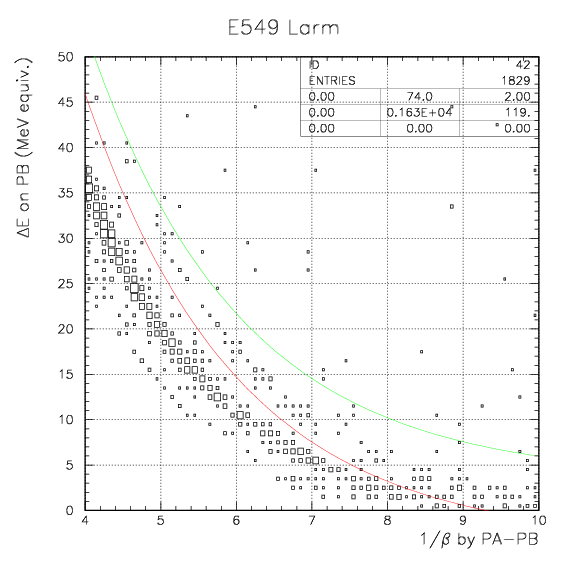
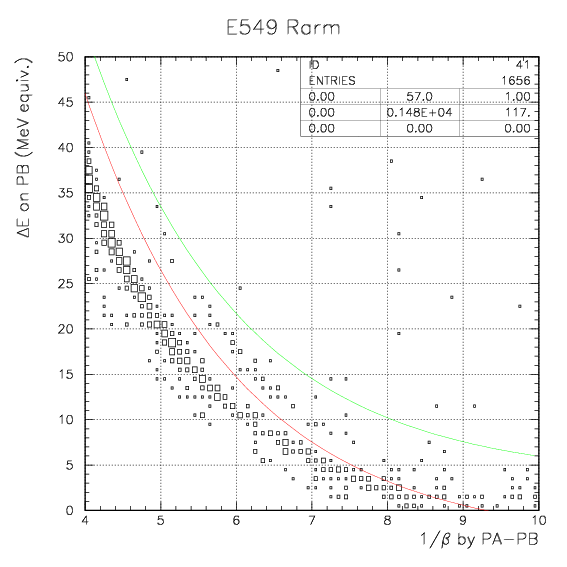

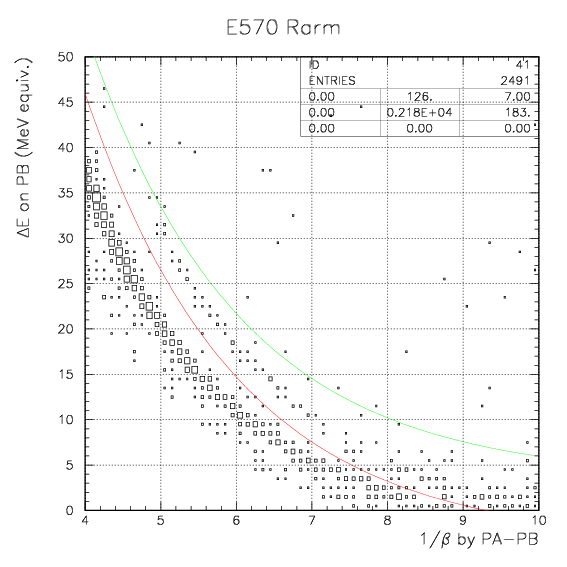 Now, we check the 1/β VS dE/dx on PA. We expect some event loss by the old triton selection.
Now, we check the 1/β VS dE/dx on PA. We expect some event loss by the old triton selection.
The correlation between 1/&beta(PA-PA) VS dE/dx on PA for "triton" events on PB. The old selection border is overlayed.

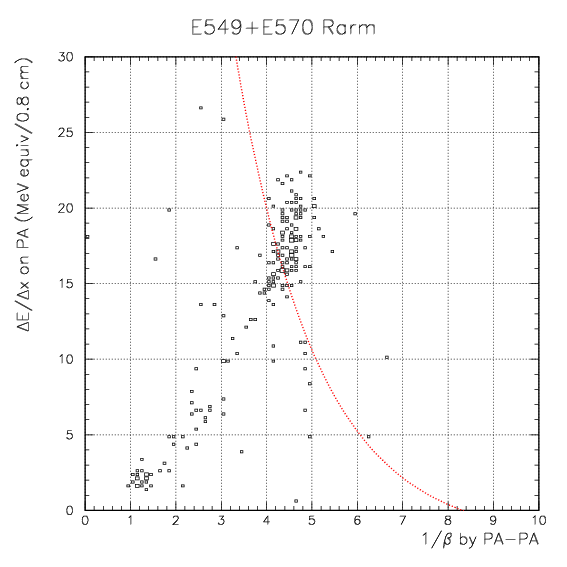
As expected, we were losing fast triton by a certain degree in the old selection, but the fraction is not large. The island at around 1/&beta ~ 1.2 corresponds to tritons produced on PA by 12C(&pi,t) reaction, and 12C(p,t) is also observed. The Λ momentum spectrum by "triton on PB" is presented below. Since triton is identified very cleanly, and the triton is likely to be produced by Λt reaction, the peak is much more clear than that observed by old triton selection. We have observed 29 events of tΛ events in total, which will be adopted later to give a preliminary estimation of the branching fraction. Furthermore, we do understand that we can impose stronger cut of cos(Λt) ≤ -0.99 without losing real Λt events, neglecting the scattering effect of slower triton which is known to be small enough compared to possible error of the cos(Λt) by chamber resolution for the triton tracking and ambiguity of the rotation angle of the chambers with respect to E549 global coodinate system.
Momentum spectrum of Λ under "triton on PB" condition. The spectrum under cos(tΛ) ≤ -0.99 is overlayed by red color.
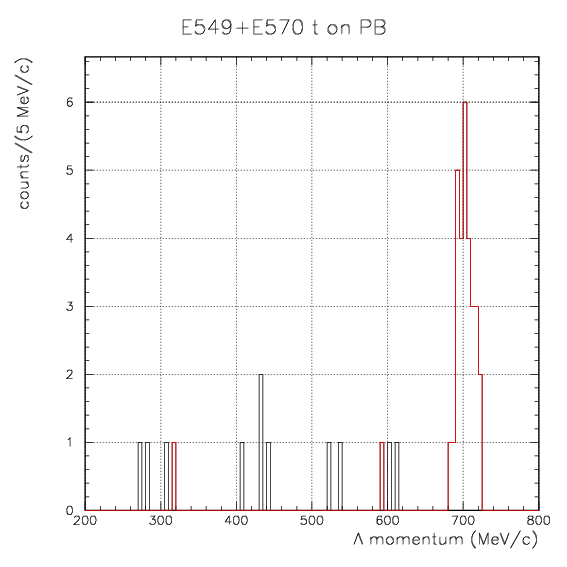 To maximize the &Lambda statistics, we take OR of "t on PA" (old) and "t on PB" (new), and we update the angler selection from cos(tΛ) ≤-0.98 to cos(tΛ) ≤-0.99 to achieve maximum S/N ratio without losing signals.
To maximize the &Lambda statistics, we take OR of "t on PA" (old) and "t on PB" (new), and we update the angler selection from cos(tΛ) ≤-0.98 to cos(tΛ) ≤-0.99 to achieve maximum S/N ratio without losing signals.
The final &Lambda spectra and peak count
The final Λ spectra in coincidence with "t on PA".OR."t on PB" are shown below. The observed peak count is then 72±2(syst)±8.5(stat) counts from the spectrum under the condition, cos(tΛ)≤-0.99. The systematic error is safely neglected in the evaluation of the branching fraction, as it is negligible compared to the statistical error and systematic error originates from the uncertainty of the capture rate to the meta-stable orbit of K-.
The final Λ momentum spectra. cos(Λt)≤-0.99 and ≥-0.99 are overlaid by red and blue, respectively. For the red spectrum, the area used for peak counting is filled.
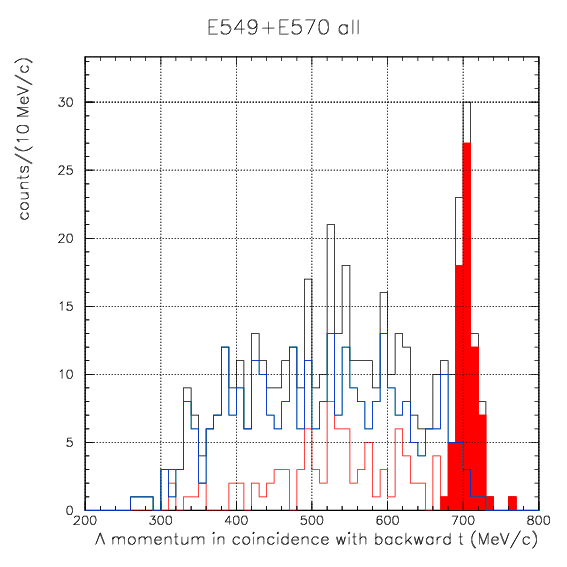
The Gaussian fitting result of the Λt peak is presented below.
The peak center is 704.7 ± 1.4 MeV/c, and the standard deviation is 11.7 ± 1.0. The center is shifted by 7.0 ± 1.4 MeV/c, so that the accuracy of the momentum scale is 1%. The standard deviation is totally consistent to the expected value of 12 MeV/c.
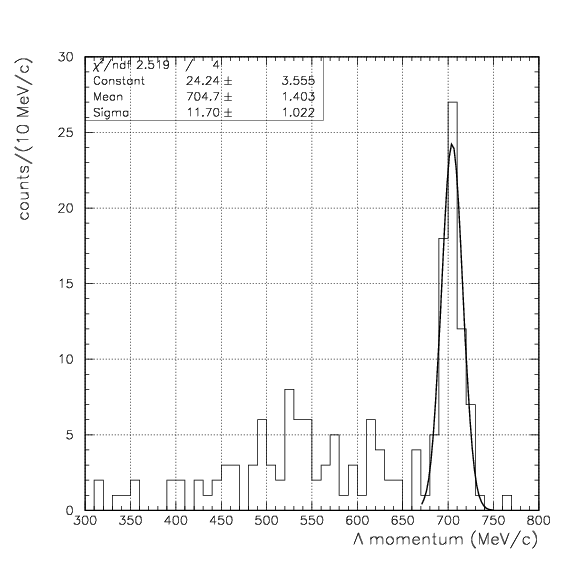
The nature of the non-Λt intensity over 670 MeV/c
Regardless of the expectation that &Sigma0t process can reach only up to ~670 MeV/c taking the momentum resolution into account, we observe non-negligible continum spectrum intensity up to over 700 MeV/c. We can understand that by 3NA, namely, Λd'n' reaction with the branching fraction of 0.1% or more. Since the "t on PA" selection is defined so as not to lose stopped triton, we should recognize that a certain fraction of "t on PA" is stopped slow deuteron on PA. Below, the momentum-momentum correlation from Λdn events is shown. In the reaction, Λ momentum can reach ~700MeV/c, when cos(Λd) is ~ -1.0. Therefore, the kinematics of the reaction is very similar to that of Λt, and the contribution cannot be completely eliminated with "t on PA" selection, but can with "t on PB" where d and t are completely separtated. In addition, the deuteron momentum of ~500 MeV/c, which corresponds to the Λ momentum of ~700 MeV/c and cos(Λd) of ~-1.0, is very likely to stop on PA. Therefore, the Λdn process is considered to be the source of the continum background at around 700 MeV/c with small cos(Λt) region as we are interested in. To examine possible over estimation of peak count, we also try to estimate the branching fraction only with "t on PB" events in which we do not see the contamination.
Deuteron momentum VS Λ momentum for the Λdn final state. Λ momentum can be over 700 MeV/c at around deuteron momentum of ~470 MeV/c for cos(Λd)~-1.0.
Branching fraction
Here, we try to estimate branching fraction by following two count numbers:
number 1 : 29 ± 0(syst) ± 5.4(stat) ("t on PB")
number 2 : 72 ± 2(syst) ± 8.5(stat) ("t on PA" .OR."t on PB"≅"triton")
The corresponding acceptance values taken from 2010 May 11th report are:
ε1Λt : 5.99(E549)/5.14(E570) × 10-2 (%) ("t on PB")
εΛt : 1.31(E549)/1.27(E570) × 10-1 (%) ("triton")
Adopting these numbers, we finally get:
Br1((4He-K-)atomic -> Λt) = (2.95 ± 0.42(syst) ± 0.55(stat)) × 10-4 per stopped K- (by "t on PB")
Br((4He+K-)atomic -> Λt) = (3.13 ± 0.45(syst) ± 0.37(stat)) × 10-4 per stopped K- (by "t on PA".OR."t on PB")
Now, we find these two are totally consistent, and we finally adopt Br((4He+K-)atomic -> Λt) by which a better statistical accuracy was achieved.



 Now, we check the 1/β VS dE/dx on PA. We expect some event loss by the old triton selection.
Now, we check the 1/β VS dE/dx on PA. We expect some event loss by the old triton selection.


 To maximize the &Lambda statistics, we take OR of "t on PA" (old) and "t on PB" (new), and we update the angler selection from cos(tΛ) ≤-0.98 to cos(tΛ) ≤-0.99 to achieve maximum S/N ratio without losing signals.
To maximize the &Lambda statistics, we take OR of "t on PA" (old) and "t on PB" (new), and we update the angler selection from cos(tΛ) ≤-0.98 to cos(tΛ) ≤-0.99 to achieve maximum S/N ratio without losing signals.

